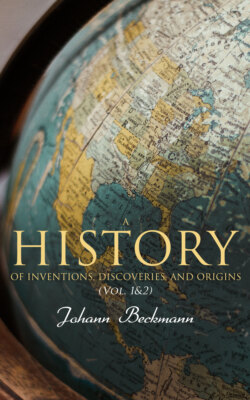Читать книгу A History of Inventions, Discoveries, and Origins (Vol. 1&2) - Johann Beckmann - Страница 29
На сайте Литреса книга снята с продажи.
FOOTNOTES
Оглавление197 [Sextus Empiricus (Adv. Math. cap. 21) says that the Chaldæans divided the zodiac into 12 equal parts, as they supposed, by allowing water to run out of a small orifice during the whole revolution of a star, and dividing the fluid into 12 equal parts, the time answering to each part being taken for that of the passage of a sign over the horizon.]
198 Lib. ix. c. 9.
199 [Some mode of measuring time by the reflux of water, however rude it might be, was used at Athens before the time of Ctesibius, as we see by various passages in Demosthenes.]
200 Auctor Dialog. de Caus. Cor. Eloq. 38.—The orators were confined to a certain time; and hence Cicero says, latrare ad clepsydram.
201 Some account of the writers who have spoken of the water-clocks of the ancients may be found in Fabricii Bibliograph. Antiquaria, p. 1011. They were formerly used for astronomical observations. The authors who treat of them in this respect are mentioned in Riccioli Almagest. Novo, i. p. 117.
202 In that year Kircher’s Ars Umbræ et Lucis was published for the first time. In the edition of 1671, several kinds of water-clocks are described, p. 698.
203 A particular account of these water-clocks is to be found in Ozanam, Recréations Math. et Physiques [republished in Hutton’s Mathematical Recreations, ii. 40]. Bion on Mathematical Instruments.
204 Muschenbroek, Philos. Natur. i. p. 143.
205 Journal des Sçavans, 1691.
206 This monk may be considered as the restorer of the clepsydra, or clock which measures time by the fall of a certain quantity of water confined in a cylindric vessel. These clocks were in use among ancient nations. They are said to have been invented at the time when the Ptolemies reigned in Egypt. Dom Vailly, who applied himself particularly to practical mathematics, having remarked the faults of these clocks, bestowed much labour in order to bring them to perfection; and by a number of experiments, combinations, and calculations, he was at length able to carry them to that which they have attained at present. At the time of their arrival they were very much in vogue in France.—Hist. Littéraire de la Congr. de St. Maur, ordre de S. Bénoit. Bruxelles, 1770, 4to, p. 478.
207 Ozanam, ii. p. 475.
208 Alexander will not admit this to be the case. “It is possible,” says he, “that two persons of penetrating genius may have discovered the same thing.”
209 Art du potier d’étain, par Salmon. Paris, 1788, fol. p. 131.
